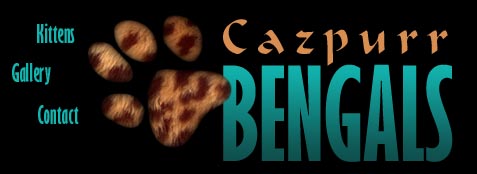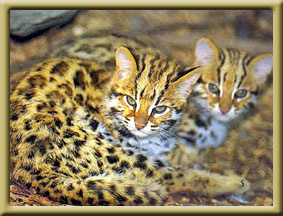

On this page I hope to answer some common questions about bengals including: What is a bengal cat? What colors and patterns do bengals come in?
How
do you care for a bengal cat? What is a Bengal Cat? The Bengal Cat is a unique domestic breed derived from crossing various breeds of domestic cats with Asian Leopard Cats. Breeders are working to create a cat that has the shape and beautiful coat of the Asian Leopard Cat and the friendly temperament of the domestic cat.
Bengal History The Bengal is descended from crosses between wild Asian Leopard Cats and domestic shorthairs. The first Bengal breeding program began in 1963 and the breed was first accepted for championship status in TICA in 1984. It is a large cat with a short glossy coat. While most commonly seen in the brown spotted tabby pattern, they may also be found in the marbled pattern (classic tabby). Glittering refers to an effect on the coat that makes it looks as if the coat was sprinkled with glitter; rosetted refers to the spots forming distinct patterns, preferably with more than one color tone within the spot. Seal sepia, seal lynx, and seal mink, color patterns with a pale white or cream background, are popularly referred to as "snow" Bengals. Well-bred Bengals are active, intelligent companions. Buyers should ask how many generations removed Bengal kittens are from wild blood; the best companion cats are at least four generations removed. Most pet Bengals are wild only in looks, not in personality. Interesting fact: An SBT (stud book tradition) Bengal represents at least four generations of Bengal-to-Bengal breeding, and thus will be no less than four generations removed from wild blood. F1 through F4 (filial) Bengals are anywhere from one to four generations removed (F1 is the offspring of a Bengal-to-Asian Leopard Cat breeding, an F2 is the offspring of Bengal-to-Bengal breeding with at least one F1 involved, and so on). An SBT cat would thus be at least an F5. Most pet Bengals are F4s or SBTs; cats with more wild blood than that may make difficult pets. Associations: The Bengal is currently accepted by most associations except CFA.
|
